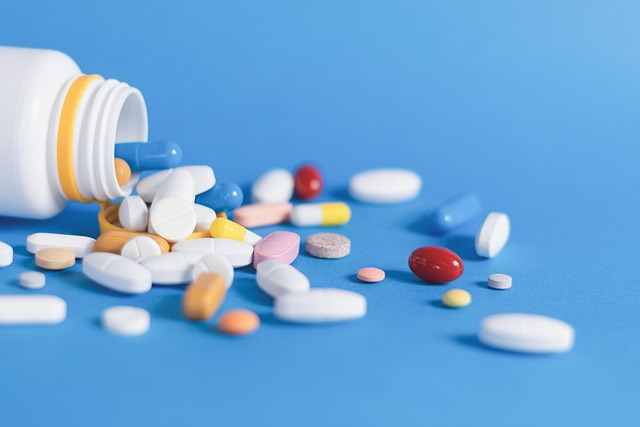GLP-1 agonists, a groundbreaking class of diabetes medications, mimic natural intestinal hormones GLP-1 to offer dual benefits: improved glycemic control and weight management. Available in injectable and oral forms, these drugs stimulate insulin release during meals and slow gastric emptying for better satiety. While effective for all, semaglutide stands out for its faster and sustained action. With potential side effects like nausea, vomiting, and pancreatitis, regular monitoring is crucial. Extensive clinical research validates GLP-1 drugs' efficacy in lowering blood sugar, promoting weight loss, and enhancing cardiovascular health. Future developments include longer-acting formulations and personalized medicine approaches to enhance patient compliance and treatment outcomes for type 2 diabetes and metabolic disorders.
“GLP-1 agonists have emerged as powerful tools in diabetes management, offering improved blood sugar control and weight management. This comprehensive article delves into the intricate world of these innovative drugs. We explore their mechanism of action, comparing efficacy across injectable and oral formulations. Key focus areas include their impact on glycemic control, weight loss, and associated side effects. By examining clinical studies and real-world evidence, we uncover the effectiveness of GLP-1 drugs, while also glancing into future trends that may shape their development.”
Understanding GLP-1 Agonists: Their Role in Diabetes Management

GLP-1 agonists, or glucagon-like peptide-1 drugs, are a relatively new class of medications that have significantly transformed diabetes management. They mimic the effects of the natural hormone GLP-1, which is secreted in response to food intake. This hormone stimulates insulin secretion when blood sugar levels are high and suppresses glucagon release, helping to lower blood glucose.
These drugs offer a unique advantage by not only improving glycemic control but also providing weight management benefits. They do this by increasing feelings of fullness, leading to reduced calorie intake and subsequent weight loss. This dual action makes GLP-1 agonists a promising game-changer in the treatment of type 2 diabetes, offering both better blood sugar control and improved overall health for patients.
Key Mechanisms of Action: How These Drugs Mimic Intestinal Hormones

GLP-1 agonists, a class of drugs used in diabetes treatment, primarily act by mimicking key intestinal hormones, specifically glucagon-like peptide-1 (GLP-1). These drugs have revolutionized glycemic control due to their multifaceted mechanisms. They stimulate insulin secretion in a glucose-dependent manner, enhancing insulin’s efficacy during meals. Additionally, GLP-1 agonists slow gastric emptying, leading to improved satiety and reduced food intake.
The drugs interact with specific receptors in the gut and brain, influencing both peripheral and central pathways involved in glucose homeostasis. By activating these receptors, they enhance the sensation of fullness, curb appetite, and reduce excessive eating behaviors. This dual action not only aids in managing blood sugar levels but also supports weight loss efforts, making GLP-1 drugs a game-changer in diabetes management.
Types of GLP-1 Agonists: Injectable vs. Oral Formulations

GLP-1 agonists, a class of drugs designed to mimic the effects of glucagon-like peptide-1, have revolutionized diabetes management. These medications come in two primary forms: injectable and oral formulations, each with its own advantages and considerations. Injectable GLP-1 drugs, administered via injections under the skin, offer faster onset of action compared to their oral counterparts. This makes them particularly effective for rapid blood sugar control, making them a popular choice among patients requiring immediate relief. However, they may not be as convenient as oral medications due to the need for regular injections.
Oral GLP-1 agonists, on the other hand, provide a more user-friendly approach with their pill form. They require no injections and can be taken conveniently at home. While their onset of action is generally slower than injectables, these oral formulations offer sustained benefits over several hours, helping to regulate blood sugar levels throughout the day. The convenience and ease of use make oral GLP-1 drugs an attractive option for many patients living with diabetes, contributing to better adherence to treatment regimens.
Efficacy in Blood Sugar Control: A Comparative Analysis

GLP-1 agonists have proven highly effective in managing blood sugar levels, making them a key consideration in diabetes treatment plans. These drugs mimic the effects of the natural hormone GLP-1, which stimulates insulin production and suppresses glucagon secretion. This dual action results in improved glycemic control. When comparing different GLP-1 drug classes, such as exenatide, liraglutide, and semaglutide, studies show that they all demonstrate significant reductions in HbA1c levels, a marker of long-term blood sugar control.
The comparative analysis reveals that while all GLP-1 drugs are similarly effective, there can be variations in their potency and duration of action. For instance, semaglutide has shown remarkable efficacy, with some studies indicating faster and more sustained blood sugar control compared to other GLP-1 agonists. This difference may impact patient preferences and treatment adherence, as individuals might experience varying levels of convenience and satisfaction with different GLP-1 drugs.
Weight Management: Exploring the Impact of Different GLP-1 Drugs

Weight management is a key aspect where GLP-1 agonists have shown significant promise. These drugs, designed to mimic the effects of natural gut hormones, play a crucial role in regulating appetite and blood sugar levels. In the context of weight loss, various GLP-1 drugs have demonstrated efficacy by increasing feelings of fullness, leading to reduced calorie intake. This mechanism not only aids in achieving a healthier body mass but also helps maintain it over time.
Different GLP-1 drugs may exhibit varying degrees of impact on weight management due to their unique chemical compositions and modes of action. Some agonists have been particularly successful in clinical trials, showcasing substantial weight loss outcomes. By targeting specific receptors in the brain and gut, these medications can substantially enhance metabolic processes, contributing to overall weight management goals.
Side Effects and Safety Profiles: What Every Patient Should Know

GLP-1 agonists, a class of drugs designed to mimic the effects of the natural hormone GLP-1, have shown significant promise in treating type 2 diabetes. However, like any medication, they come with potential side effects and safety considerations that patients should be aware of. These drugs primarily act on the gut to stimulate insulin release and inhibit glucagon secretion, leading to improved blood sugar control. Common short-term side effects include nausea, vomiting, and diarrhea, which are often mild and tend to lessen over time as the body adjusts. Long-term safety profiles for GLP-1 drugs have been well-studied, with no significant cardiovascular risks identified in most patients.
Despite their benefits, there are rare but serious side effects to consider. These include pancreatitis and kidney problems. Patients with a history of gastrointestinal issues or kidney disease should exercise caution and discuss the potential risks with their healthcare provider. Regular monitoring of kidney function and blood sugar levels is recommended during treatment with GLP-1 drugs. Moreover, patients should report any unexpected symptoms or changes in their health status promptly. By understanding these safety aspects, patients can make informed decisions about their diabetes management and work closely with their doctors to optimize GLP-1 drug therapy.
Clinical Studies and Real-World Evidence: Uncovering Treatment Effectiveness

Clinical studies and real-world evidence play a pivotal role in understanding the true efficacy of GLP-1 agonists. Rigorous clinical trials have demonstrated these drugs’ ability to significantly lower blood sugar levels, reduce weight, and improve cardiovascular outcomes in patients with type 2 diabetes. Real-world data further bolster these findings, offering insights into how GLP-1 drugs perform in diverse patient populations and various healthcare settings.
Studies show that GLP-1 agonists can lead to sustained blood glucose control, often resulting in reduced reliance on insulin therapy. They have also been linked to improvements in kidney function and a lower risk of hypoglycemia compared to other diabetes medications. Real-world evidence collected from large patient cohorts has confirmed these benefits while also identifying potential side effects, such as gastrointestinal issues, which can inform patient selection and management strategies.
Future Perspectives: Emerging Trends in GLP-1 Agonist Development

The future of GLP-1 agonist development promises exciting advancements in treating type 2 diabetes and other metabolic disorders. Researchers are continuously exploring novel mechanisms to enhance their efficacy, safety, and convenience. One emerging trend is the development of long-acting GLP-1 drugs with extended duration of action, potentially reducing the frequency of administration. This could significantly improve patient compliance and adherence to treatment regimens.
Additionally, there is a growing interest in personalized medicine approaches, tailoring GLP-1 therapies to individual patient needs. This may involve designing drugs that target specific biological pathways or combining GLP-1 agonists with other classes of diabetes medications for synergistic effects. Emerging technologies like gene therapy and advanced delivery systems could also revolutionize GLP-1 drug administration, making them more accessible and user-friendly.
